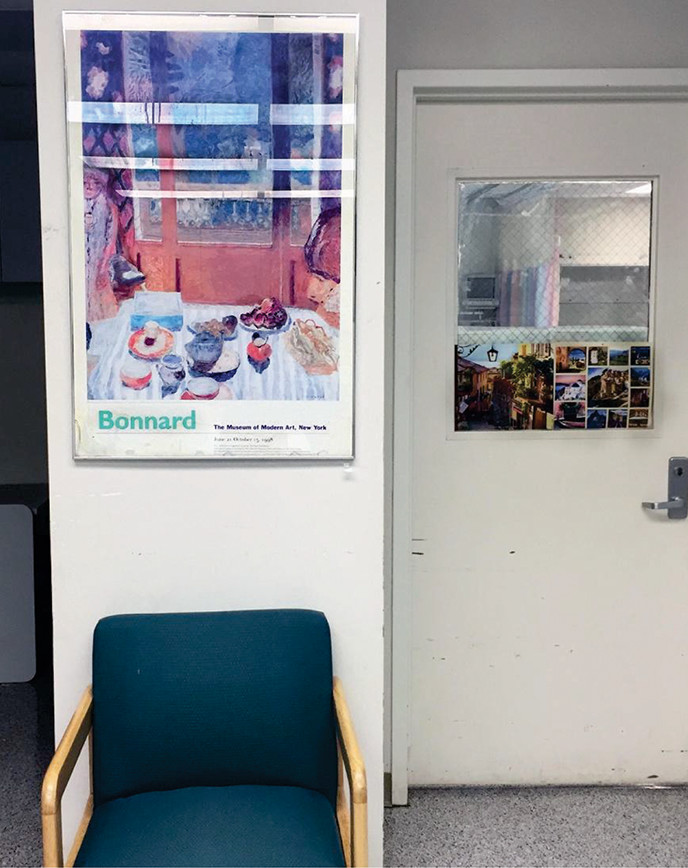Pierre Bonnard (1867–1947) was a French painter whose best-known works were produced at the turn of the 20th century. He painted ordinary subjects—quiet interiors, still life, and intimate portraits of young women—with rich patterns and a vibrancy that garnered him a reputation as one of the premier colorists of the century. Bonnard not only understood the chemical and physical dimensions of color, he also understood its psychological effects.
A poster of a Pierre Bonnard painting titled "Dining Room Overlooking the Garden," faded and subtly buckling behind a protective glass covering, hangs opposite a gurney where patients lie during ECT. Patients may contemplate this serene image of a Parisian breakfast, rendered in sublimely vibrant tones and from multiple perspectives, as they await the sedating and hypnotic effects of anesthesia.
On the left-hand side of the image is a figure camouflaged among a lattice and flower backdrop. The painting is thought to represent a house in which Bonnard’s reclusive wife Martha resided while attending a sanitarium. The image construction tempts viewers to ignore Martha in the corner, not only because of the bright color of the table and allure of the trees in the distance, but also because the perspective, which rises vertiginously upward, simulates a gaze that is focused on the table and the lyrical foliage in the distance. A padded armchair in front of the poster extends the painting’s mise en scéne into the medical suite. Like Martha, the patient across from this image is also temporarily housed in a therapeutic environment, perhaps feeling as uncomfortable and apprehensive as Martha appears, pressed so tightly against the wall that she blends in with the decor.
Bonnard famously said, "There is a motto that suits painting perfectly: many small lies yield a great truth" (
1). In Bonnard’s art, these small lies are depictions of the world in hyperbolized color, distorted but beautiful forms hidden in plain sight. The sum of these patterns may reveal truths about the physical and psychological world. This is also true in medicine, in which histologic and radiographic images allow physician-scientists to reveal and decipher otherwise hidden information.
Bonnard’s statement about painting may serve as a metaphor for the clinical encounter, during which a series of seemingly mundane facts may yield larger truths. Although the particular elements of a patient’s story may seem patchy or out of sequence, their gestalt conveys a profound experience. In this way, Bonnard’s breakfast room appears distorted for those who aren’t themselves in the scene, sitting at the table by the window, able to take it all in. This is particularly relevant for psychiatry in which the patient may experience the world in ways unavailable to the clinician. This faded Bonnard poster in an ECT suite serves as a subtle reminder of the importance of looking through and beyond the facts to see the richly colored textures of individuals’ lives.

